The sun sets earlier now. We start to hear the rustle of tree tops, reminding us they’re here.
Yes, the Dark Ones are a presence not felt since last Winter. They are back.
That blessed cool darkness. The woods a deeper dark. The Watchers of the cold months are beckoning. Take notice.
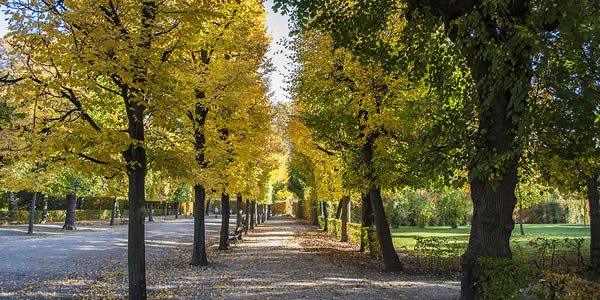
This is a sensual time of year. Leaves starting to change, cooler air. Stop and smell the scents. Taste what is growing and in season, ready to be harvested. Hear the birds. The season of the Witch has begun.
When day-time and night-time are equal,
When sun is greatest and least,
The four Lesser Sabbate are summoned,
again Witches gather in feast.
Doreen Valiente
Equinox marks the major harvest. Light and darkness stand in balance, equal hours of night and day, but the darkness is gaining, and with it: barren winter. So now, for some lore of the Dark Ones as incoming darkness prevails.
Baobhan Sith
The Baobhan Sith is a particularly evil and dangerous female vampire from the highlands of Scotland. They were supposed to prey on unwary travelers in the glens and mountains. The name suggests a form of Banshee.
The term is Scots Gaelic and means ‘wicked woman fairy’. They appear first as crows or ravens, then as lovely women. Their wails can be heard for miles around.
The ghostly White Women seduce travelers by night with their unearthly beauty and mesmerizing dancing. They engage their victims in a wild, hypnotic dance, and once they reach exhaustion, exsanguinate their partners with their vampiric kiss.
They are wonderful dancers who often dance, completely nude, in the moon’s glow with their deer hooves as feet and they are avid shape-shifters and transform from their humanoid appearance to woodland animals.
Scarecrows
Scarecrows are as old and as mysterious as human nature and have been useful to humans since the mists of early time.
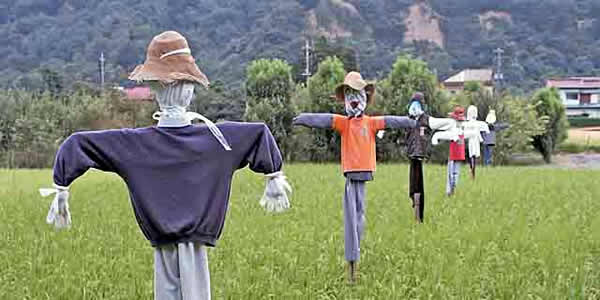
The Egyptians used the first scarecrows in recorded history to use to protect wheat fields along the Nile River.
Greek farmers in 2,500 B.C. carved wooden scarecrows ugly enough to scare birds away from the vineyards and ensure good harvests. They painted their wooden scarecrows purple and put a club in one hand to scare away the birds and a sickle in the other for a good harvest.
The Romans copied the Greek scarecrow custom and when Roman armies marched through Europe they introduced scarecrows to the people there. Almost simultaneously with the Greeks and Romans, Japanese farmers made scarecrows to protect their rice fields. They made scarecrows called kakashis, shaped like people. They dressed the kakashis in a raincoat and a round straw hat and often added bows and arrows to make them look more threatening.
In Germany, scarecrows were wooden and shaped to look like witches. Witch scarecrows were supposed to hasten the coming of spring. In medieval Britain, young boys and girls were used as live scarecrows or “bird scarers.” They would patrol the fields of crops and scare away birds by waving their arms or throwing stones. In later times, farmers stuffed sacks of straw, made faces of gourds, and leaned the straw man against pole to scare away birds.
In the United States, immigrant farmers made human looking scarecrows called “bootzamon,” which later changed to bogeyman. They were dressed in old clothes with a large red handkerchief around their necks.
There is a belief that they actually move around at night, sneaking through the fields, protecting their owner’s property and watching out for troublemakers.
Blackbirds
We call on them for skill and cunning. They seem to come alive in the Fall and take on a more mystic persona for me, than at any other time of year.
The blackbird has a long magickal history. They usher in the autumn season of magick and change as they perch at the gateway between the worlds. A gatherer, the blackbird is always on the hunt for leftover grain standing in the fields or a bird feeder. They are clever and capable, as well as relentless in the pursuit of its goals.
Dryads
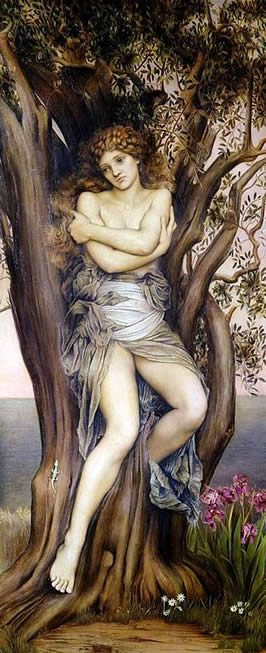
Dryads are spirits of nature (nymphs), who preside over the groves and forests. Each one is born with a certain tree over which they watch. A dryad either lives in a tree, in which case they are called a hamadryad, or close to it. The lives of the dryads are connected with that of the trees; should the tree perish, then they die with it. The dryads themselves will also punish any thoughtless mortal who would somehow injure the trees.
This doesn’t mean they have to remain rooted to the spot and grow bark; they do get to frolic in the forest. Most Dryads are very shy and terribly nervous of straying too far from the safety of their tree.
Dryads are able to move from tree to tree and dance in the forest groves. Unless they are surprised, dryads can disappear by stepping into a tree.
Trows
Known in the Shetland and Orkney Islands, they are also called Night Stealers or Night Creepers.
Squat and misshapen, with wild hair and sallow faces, they are smaller than most humans.
Some tales declared that a trow could pass for a human, although usually old, wizened or deformed, in general they were said to be short, ugly, stunted creatures.
Never seen in daylight, they go out during the hours of darkness to visit, as soon as humans have gone to bed.
Once a household had retired for the night, the trows would enter the building and sit by the glowing fire. Numerous tales recount how the terrified farmer and his wife would lie in bed listening to their unwanted guests scuttling around in the other end of the house.
Trows live inside old burial mounds, or sometimes caves. They hold great feasts and are especially fond of music and dancing. These creatures also kidnap children and leave changelings in their place.
The term is derived from Scandinavian ‘troll’, meaning bewitched.
Spriggans
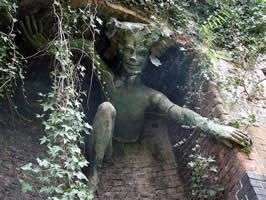
Spriggans is the name given to a family of fairies in Cornish folklore, they are closely related to Piksies, but were generally believed to be darker and more dangerous than their mischievous cousins. Whereas Piksies are generally described as being cheerful and fun loving, Spriggans are more spiteful and full of malice, directed at humans in the form of evil tricks.
It was believed that the Spriggans haunted the lonely places such as castle ruins, barrows, certain standing stones and windswept crags. Spriggans were thought to be the source of such misfortunes as blighted crops, bad weather and illness, especially in a time when the mechanics of such things were not fully understood. They were also want to steal small children and replace them with their own kind, a common trait in many of the fairy races of folklore.
In appearance the Spriggans are described as grotesquely ugly with wizened features and crooked skinny bodies. They form part of the fairy bodyguard, ready to dish out summary justice to those who would harm their otherworldly cousins.
Derived from Cornish, meaning ‘spirit’. They are the guardian spirits of sacred sites, and warn that anyone damaging ancient stone circles and holy places will suffer their wrath.
Cailleach
The goddess known as Cailleach in Scotland and parts of Ireland is the embodiment of the dark mother, the harvest goddess, the hag or crone entity. She appears in the late fall, as the earth is dying, and is known as a bringer of storms. She is typically portrayed as a one-eyed old woman with bad teeth and matted hair. Mythologist Joseph Campbell says that in Scotland, she is known as Cailleach Bheur, while along the Irish coast she appears as Cailleach Beare. Her name is varied, depending on the county and region in which she appears.
In Scottish-Gaelic the word cailleach itself means “veiled one” or “old woman”. In some stories, she appears to a hero as a hideous old woman, and when he is kind to her, she turns into a lovely young woman who rewards him for his good deeds. In other stories, she turns into a giant gray boulder at the end of winter, and remains this way until Beltane, when she springs back to life.
Gods of the Dark Forest
The Green Man is the guardian and revealer of mysteries.
He speaks of the mysteries of creation in time, of the hidden sources of inspiration,
and of the dark nothingness out of which we come and to which we return.William Anderson ‘Green Man’
Harvest Lord
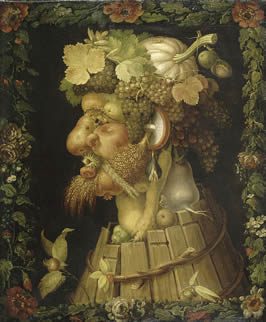
He is an ancient symbol of the slain god, the willing sacrifice, the sacred king and seed. He is the Green Man seen in the cycle of nature in the plant kingdom. The Harvest Lord is cut down and his seeds planted into the earth so that life may continue to be abundant. The planted seed nourished beneath the soil becomes the harvested plant at the time of the Autumn Equinox.
Cernunnos
Cernunnos, the Horned God of the Celts and Gauls, the god of fertility, animals and the Underworld, is guardian in this world and the Otherworlds. He is one and the same spirit of vegetation that dies with the end of the harvest. Another aspect of the Green Man and of Herne the Hunter.
Sometimes shown with hair of vegetation. As Lord of the Forests, he was attended by snakes, deer and other animals.
Green Man
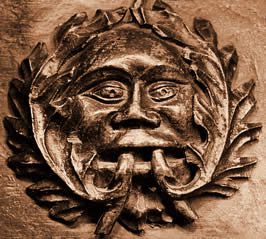
He brings us wildness with tenderness and strength. Spirit of the forest and the wilderness, like the world of vegetation is rebirth and renewal. He guides and protects us on our journeys into the darkness.
This god of nature is all around us. A mysterious fellow who wears many faces. He is a life force of the woods, the fields, and the spirit of energy and nature. He demands that we look a little deeper at nature and search within to find the connection. No matter where we live, in city, rural area or in between, he is all around us. He’s at the farmer’s market, in the ivy that grows up your apartment building walls, and the tough weeds that crop through cracks n the sidewalk. He’s a link between ourselves and the spiritual side of nature.
Crone
We have entered the time of the Wise women…
The Crone, who laughs aloud and speaks her truth without fear.
She is the Old One who snips away all that is no longer needed or useful.
This is the season of the Grandmother who passes her wisdom to future generations.
Autumn is embracing the season of the Hag, keeper of sacred knowledge and deeper mysteries.
The Gatekeeper who holds open the door to all magical ways.
The amazing Witch with power to bend or shape consciousness as Alchemist who magically transforms ordinary reality…taking us into a quieter time of relaxation, introspection, reflection, release.
It’s the season of the Witch.


Patheos Pagan on Facebook.
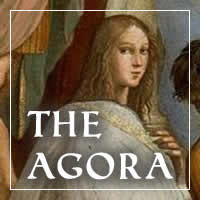
the Agora on Facebook
Outside the Circle is published twice monthly on Thursdays on Agora. Subscribe via RSS or e-mail!
Please use the links to the right to keep on top of activities here on the Agora as well as across the entire Patheos Pagan channel.















